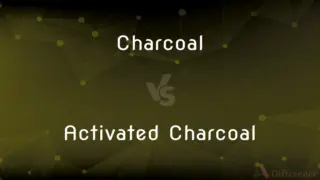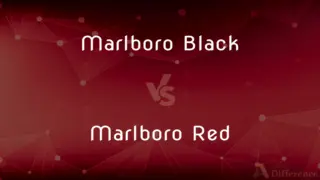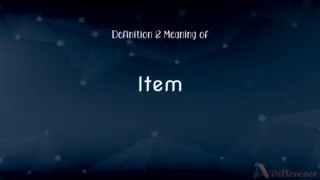Pellet vs. Sinter — What's the Difference?
By Fiza Rafique & Maham Liaqat — Updated on May 17, 2024
"Pellet" refers to small, rounded or cylindrical particles often used in various industrial processes, while "sinter" describes a mass of particles that have been fused together by heat without melting completely.

Difference Between Pellet and Sinter
Table of Contents
ADVERTISEMENT
Key Differences
Pellet" typically refers to small, solid particles formed into a rounded or cylindrical shape. These are commonly used in industries such as agriculture, pharmaceuticals, and metallurgy. "Sinter" describes a solid mass created by heating powdered material just below its melting point until the particles adhere to each other. This process, known as sintering, is used in metallurgy, ceramics, and other fields to create strong, solid objects from powders.
Pellets are usually pre-formed and used as a raw material or product in various applications, whereas sintering is a process that transforms powdered materials into a coherent mass with enhanced properties.
Pellet production often involves extrusion or pelletizing processes, making it suitable for materials requiring consistent shape and size. In contrast, sintering involves thermal treatment, enhancing material properties such as strength, density, and structural integrity.
Pellets are primarily about shape and ease of use, while sintering is about changing material properties through heat.
Comparison Chart
Definition
Small, rounded or cylindrical particles
Mass of particles fused together by heat
ADVERTISEMENT
Formation Process
Extrusion, pelletizing
Sintering (heating below melting point)
Primary Use
Raw material or product in various industries
Creating strong, solid objects from powders
Characteristics
Uniform shape and size
Increased strength and density
Examples
Plastic pellets, animal feed pellets
Sintered metal parts, ceramic components
Compare with Definitions
Pellet
Made from diverse materials like plastic, metal, or organic matter.
Wood pellets are commonly used for heating.
Sinter
Used in metallurgy, ceramics, and other fields.
Sintered gears are common in the automotive industry.
Pellet
A small, rounded, or cylindrical particle.
The plastic pellets were used as raw material for manufacturing.
Sinter
Involves heating material just below its melting point.
Ceramic components are often produced through sintering.
Pellet
Used in various industries for ease of handling.
Pharmaceutical companies use pellets for controlled drug delivery.
Sinter
Enhances material properties such as strength and density.
The sintered component was much stronger than the original powder.
Pellet
A small, solid or densely packed ball or mass, as of food, wax, or medicine.
Sinter
Transforms powdered materials into solid, coherent objects.
The sintered filter had excellent structural integrity.
Pellet
A bullet or piece of small shot.
Sinter
(Geology) A chemical sediment or crust, as of porous silica, deposited by a mineral spring.
Pellet
A stone ball, used as a catapult missile or a primitive cannonball.
Sinter
A mass formed by sintering.
Pellet
To make or form into pellets.
Sinter
To cause (metallic powder, for example) to form a coherent mass by heating without melting.
Pellet
To strike with pellets.
Sinter
To form a coherent mass by heating without melting.
Pellet
A small, compressed, hard chunk of matter.
A pellet of wood, paper, or ore
Sinter
(geology) An alluvial sediment deposited by a mineral spring.
Pellet
A lead projectile used as ammunition in rifled air guns.
Sinter
A mass formed by sintering.
Pellet
Compressed byproduct of digestion regurgitated by owls and many other birds of prey, which serves as a waste disposal mechanism for indigestible parts of food, such as fur and bones.
Sinter
A mixture of iron ore and fluxes added to a blast furnace.
Pellet
(heraldry) A roundel sable (black circular spot).
Sinter
To compact and heat a powder to form a solid mass.
Pellet
One of the short conductive tubes in a Pelletron particle accelerator.
Sinter
Dross, as of iron; the scale which files from iron when hammered; - applied as a name to various minerals.
Pellet
To form into pellets.
Sinter
Used of powdery metals or ores; to cause to become a coherent mass by heating without melting
Pellet
To strike with pellets.
Sinter
A mass of particles fused together by heat.
The metal part was created by sintering iron powder.
Pellet
A little ball; as, a pellet of wax on paper.
Pellet
A bullet; a ball for firearms.
As swift as a pellet out of a gun.
Pellet
To form into small balls; to pelletize.
Pellet
A small sphere
Pellet
A solid missile discharged from a firearm;
The shot buzzed past his ear
Pellet
Formed by extrusion or pelletizing processes.
The animal feed was converted into pellets for easier distribution.
Pellet
Often uniform in shape and size.
The fertilizer was sold in the form of small, uniform pellets.
Common Curiosities
What is a pellet?
A pellet is a small, rounded, or cylindrical particle used in various industrial applications.
What is sintering?
Sintering is a process where powdered material is heated just below its melting point to fuse particles together.
What are sintered materials used for?
Sintered materials are used to create strong, solid objects in metallurgy, ceramics, and other industries.
Can pellets be made from any material?
Yes, pellets can be made from materials like plastic, metal, organic matter, and more.
What is the main benefit of sintering?
The main benefit of sintering is the improved strength and density of the resulting material.
How are pellets made?
Pellets are made through extrusion or pelletizing processes, forming materials into uniform shapes.
Why are pellets used in manufacturing?
Pellets are used for their ease of handling, uniform size, and suitability for various processing techniques.
Are pellets always uniform in size?
Pellets are typically uniform in size for consistent application and processing.
What industries use sintering?
Industries like metallurgy, ceramics, automotive, and aerospace use sintering to enhance material properties.
Does sintering involve melting the material?
No, sintering involves heating the material just below its melting point.
Can sintered materials be re-melted?
Yes, sintered materials can often be re-melted or further processed as needed.
What is an example of a sintered product?
An example is a sintered metal gear used in automotive transmissions.
What is a common use of pellets in agriculture?
Pellets are commonly used as animal feed in agriculture.
What is the key difference between pellets and sintered materials?
Pellets are pre-formed particles for ease of use, while sintered materials are formed through a heating process to enhance strength and density.
Does sintering change the chemical composition of the material?
Sintering primarily changes the physical properties, not the chemical composition.
Share Your Discovery

Previous Comparison
Sumac vs. Zaatar
Next Comparison
Dragonfly vs. AntlionAuthor Spotlight
Written by
Fiza RafiqueFiza Rafique is a skilled content writer at AskDifference.com, where she meticulously refines and enhances written pieces. Drawing from her vast editorial expertise, Fiza ensures clarity, accuracy, and precision in every article. Passionate about language, she continually seeks to elevate the quality of content for readers worldwide.
Co-written by
Maham Liaqat














































